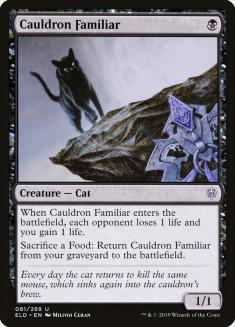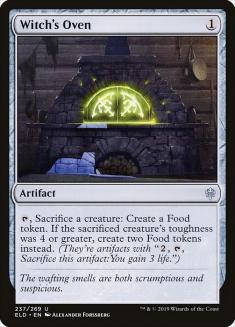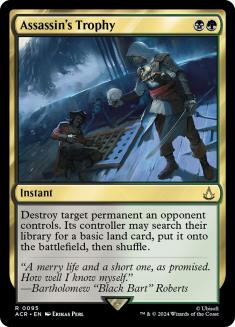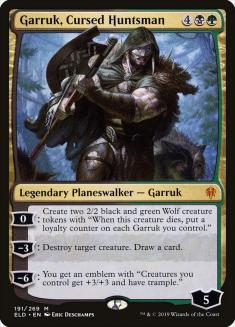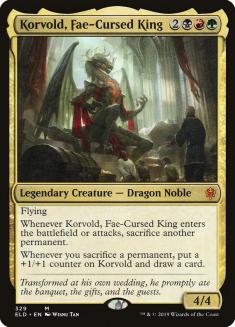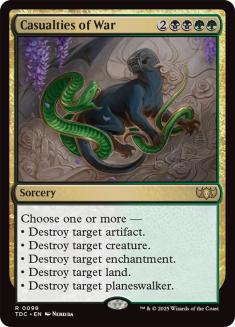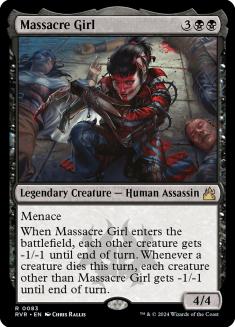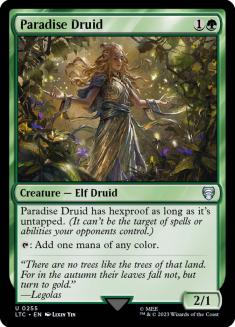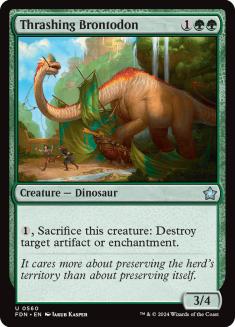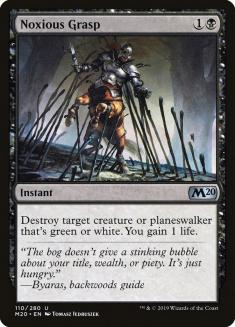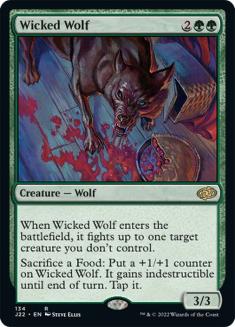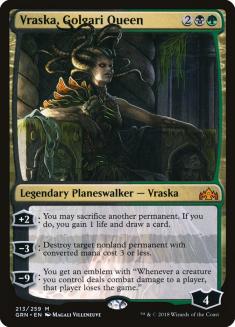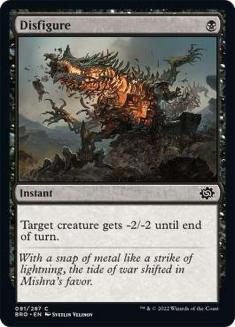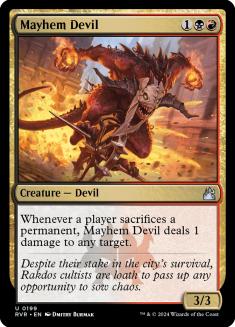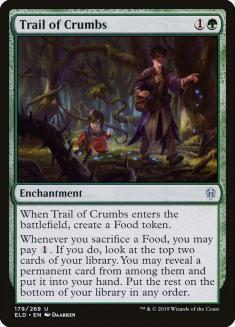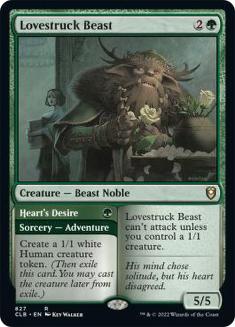I recently participated in the Twitch Rivals Arena tournament – a two-day, 275-player Arena event designed to be our first showcase of what Throne of Eldraine Standard could be when the oppressive yoke of Oko, Thief of Crowns was cast aside. I locked up a Top 16 finish and a decent chunk of change with a newly retooled version of Jund Sacrifice. My build continued to prove its worth throughout the first week of play, taking down multiple PTQs and coming up just short in the Magic Online PTQ. My list:
Creatures (20)
- 1 Midnight Reaper
- 4 Paradise Druid
- 4 Mayhem Devil
- 1 Massacre Girl
- 4 Gilded Goose
- 1 Korvold, Fae-Cursed King
- 1 Wicked Wolf
- 4 Cauldron Familiar
Planeswalkers (5)
Lands (19)
Spells (16)

I love new Standard formats. I rely more on deckbuilding than technical play to find my edge in a match of Magic, and the delta between good decks and mediocre ones is most pronounced at a format’s start. I’ve previously written about what allows me to routinely find success in new Standard environments. In this summation of my approach I spoke to four important principles for Week 1 deck selection:
- Painting with a Broad Brush
- Taking Advantage of Holes in Sideboards
- Outscale Everything
- Identify Tools That Survived and Found Substantial Upgrades
Jund Sacrifice embraces these principles, and I want to use them as the framework for discussing how I arrived at this build.
Painting with a Broad Brush
Painting with a broad brush asks us to make somewhat sweeping conclusions about the format, and account for those conclusions in card and deck selection. Three conclusions were my focal point for Twitch Rivals. First, the absence of Oko from the format would unlock aggressive decks such as Rakdos Knights and Mono-Red. Second, Witch’s Oven plus Cauldron Familiar is the best form of inevitability in the format. Finally, Fires of Invention possessed the most inherent power of any archetype and would run over the tournament if left unaccounted for. These conclusions came from an imprecise combination of experience with the previous format, discussions with other players, social media chatter, and an extremely limited amount of time on the Arena ladder. With a small window for preparation (less than 24 hours), you take what you can get.
For the most part, these conclusions seemed to hold. Brad Nelson wrote about Twitch Rivals last week and you can see that Jeskai Fires led the way, with 27 copies on Day 1 and a strong Day 2 conversion rate with seven players making the cut. Rakdos Aggro was not far behind, with 21 copies on Day 1 and four players making Day 2. Cat Food combinations also showed up in force, with 34 players leveraging the combo on Day 1 and six players headed to Day 2. Mono-Red did not have the quite the impact I had expected with eleven copies in Day 1 and two players advancing to Day 2, but, at those numbers, it was still a matchup I was glad I contemplated.
The decision to play the macro-archetype of a Cat Food deck was somewhat predicated on playstyle preference and past experiences. While Fires was higher on my raw power rankings, Cat Food builds seemed to have greater customization in deckbuilding, whereas my Fires list was basically going to be a persistent check on whether my opponents had appropriately done their homework and accounted for my archetype in deckbuilding. With so many talented folks participating in the tournament, I expected the answer to that question to increasingly be “yes” as the tournament wore on.
As far as the version of the Cat Food package I chose to play, I felt that Mayhem Devil was a key card against the expected metagame, and its existence alone drove me to play Jund Sacrifice. The ability to mitigate opposing engines (it triggers off all sacrifices, not just yours) meant that I was starting most mirrors with a leg up. Mayhem Devil also accelerated my clock dramatically, and the only real chance I felt I had against Fires of Invention in Game 1 was an oddly aggressive draw. Mayhem Devil thankfully allowed me to move away from Massacre Girl and put some real power at the top-end of my mana curve.
Specific card inclusions also spoke to these conclusions. Assassin’s Trophy is probably a “worse” card in this shell than Murderous Rider, especially when you account for Rider’s synergy with Trail of Crumbs. However, the flexibility against something like Fires of Invention and the ability to answer a resolved Embercleave in Game 1 pushed me towards Assassin’s Trophy. I reaped the benefits of this decision all day long.
Garruk, Cursed Huntsman will garner some discussion under every single one of these principles, and rightfully so. In many ways, I think it is the trademark alteration of my deck from stock builds. Garruk gets opponents dead in a way the Liliana, Dreadhorde General simply can’t. Closing speed is incredibly important in a format defined by the tremendous late games of Cat Food and Fires of Invention. 4+8+12 reads a turn faster (and then some) than 2+4+6+8 and plays much better through removal or recursive blockers. This says nothing of the rapid emblem production that playing multiple copies of Garruk unlocks.
Taking Advantage of Holes in Sideboards
Sideboards prior to the Oko ban were starting to aggressively target Cat Food decks. Leyline of the Void had begun to pop up in large numbers, and it seemed like this should continue for the Twitch Rivals tournament. I wanted to be sure I had ways to punish decks that were overly focused on shutting down my combo. The entire core of this deck contemplates this goal, as Garruk and Mayhem Devil do a much better job winning games in the absence of the combo than Massacre Girl and Liliana.
While I thought sideboard numbers would mostly hold for Cat Food hate, I anticipated a dramatic reduction in the number of Noxious Grasps in a post-Oko world. This helped to unlock Garruk, Cursed Huntsman as a card. Maybe even more importantly, Korvold, Fae-Cursed King would get a chance to shine.
I was hesitant to go particularly hard on the Brawl legend, thinking it would only be good at parity or when ahead. I’m happy to report that Korvold was game-breaking every single time I drew it in the tournament, and you should be playing at least two if not three copies going forward. An evasive threat capable of ending the game in a single swing, all while refilling your grip, is not something that comes around all that often. It was common for me to draw six or seven cards on the turn Korvold entered the battlefield. Close games became unlosable, desperate games became nail biters, and advantaged situations meant Korvold elicited an instant scoop. This kind of power should not be ignored, and if Noxious Grasp remains out of maindecks and appearing at a lower density, Korvold will dominate games.
Outscale Everything
In many ways, I accomplished this goal simply by choosing to play a Cat Food deck. There’s some argument that a functioning Jeskai Fires deck can go larger, especially with access to Fae of Wishes, but I’m not 100% sure I buy that. Jeskai is especially good at setting up a singular powerful turn. If you survive that turn, their engine begins to show some faults, instilled mostly by the two-spell-per-turn limitation of Fires of Invention. The first time Fires cast Casualties of War against me for five targets and it had absolutely no influence over the course of the game simply because I had drawn two Trail of Crumbs was a real eye-opener.
This meant the deck I was supposed to be to outscaling was the mirror. Garruk and Korvold were the two perfect ways to do so. The evasion and card advantage inherent in both gave me a substantial edge against things like Golgari Food decks focused more on Feasting Troll King. I do think there is a valid path forward for Golgari, but it looks more like the Casualties of War-focused build we saw do well in the Magic Online PTQ. If you are going to plan on answering your opponent’s engine with removal, you had better commit to that plan, and I think the full four copies of Casualties appropriately does so.
Creatures (23)
- 3 Thrashing Brontodon
- 2 Midnight Reaper
- 4 Paradise Druid
- 3 Massacre Girl
- 4 Gilded Goose
- 3 Murderous Rider
- 4 Cauldron Familiar
Lands (16)
Spells (21)
Sideboard

Identify Tools that Survived and Found Substantial Upgrades
More than anything, I was proud of myself for leaning on this principle, as I previously identified the upgrade approach as one of my most underutilized styles of deckbuilding. The team that introduced this deck at the most recent Mythic Championship found something special. The core engine took some hits from the bannings, but nothing that proved to be fatal. Garruk and Korvold may not be upgrades over Oko, but they are indisputably powerful cards and they lit the way forward for me to make a successful first foray into new Standard.
Going forward, I would make a small adjustment of -1 Swamp, -1 Midnight Reaper, -1 Castle Locthwain, +1 Mountain, +1 Fabled Passage, and +1 Korvold, Fae Cursed King. This leaves us with the following configuration:
Creatures (20)
- 4 Paradise Druid
- 4 Mayhem Devil
- 1 Massacre Girl
- 4 Gilded Goose
- 2 Korvold, Fae-Cursed King
- 1 Wicked Wolf
- 4 Cauldron Familiar
Planeswalkers (5)
Lands (18)
Spells (17)

With this setup, I would sideboard against the established top decks in the following fashion:
VS Jund Sacrifice
The mirror revolves around haymakers and restricting your opponent’s access to their engine. Denying the Cat Food setup is a temporary achievement, and for that reason, I don’t want to max out on answers to that angle of attack. Instead, I am focusing on having as many impactful draw steps as I can, and Paradise Druid has a huge amount of vulnerability every single time it is tapped for mana.
There are four primary paths to victory you should be constantly aware of:
1. An unchecked combination of Witch’s Oven, Cauldron Familiar, and either Trail of Crumbs or Mayhem Devil.
2. A Vraska that either ultimates or denies your opponent significant resources.
3. A Korvold that lives for two or three turns.
4. A Garruk ultimate.
All decisions made in the mirror should be in furtherance of achieving or preventing one of these goals.
VS Golgari/Selesnya Adventures
These matchups seem favorable, even after a dramatic decrease in the number of Massacre Girls. Your card advantage engine outpaces everything their deck can do besides Edgewall Innkeeper, and it is trivially easy to keep that card off the battlefield now that we have Mayhem Devil. The games you lose are usually dominated by Questing Beast. Be conservative with your potential answers to the powerful legend, and I like your chances.
VS Jeskai Fires
This is the matchup that scares us the most as Jund Sacrifice players, but I made sure to hedge against the matchup in deckbuilding as much as I could. Fires is hyper-reliant on having its namesake card on the battlefield to unlock its potential. You are very good at preventing that card from being on the battlefield with four Duress, three Brontodon, and two Assassin’s Trophy. Garruk again shows its worth by closing games more quickly than comparable options like Liliana, Dreadhorde General. Don’t keep a hand without a reasonable path to a clock, and pressure as much as you can without just scooping to a Deafening Clarion. It’s a challenging tightrope to walk. Games are winnable, but you are clearly the underdog in the matchup.
VS Gruul Aggro
Gruul continues to trend down in popularity, which is a boon for Jund Sacrifice because the matchup tends to be extremely close. Many of their threats are singularly problematic, and our engine doesn’t quite line up with what they are doing which is why we decrease the number of all our pieces in sideboard games. Trade aggressively in the early-game and get to a place where one of your card advantage engines can pull you ahead. If you can survive an early onslaught backed by an Embercleave, I like Korvold’s ability to end the game in a single swing.
VS Mardu Knights
This is an aggro matchup you are far more equipped to deal with. If you can avoid starts like three one-drops into Embercleave, you will have time to set up engine pieces that really obliterate the offense of a deck incapable of generating card advantage. In sideboard games, their best path to victory is a Rotting Regisaur carrying an Embercleave. Any other threat will get murdered by Mayhem Devil or Wicked Wolf. Try to ration your removal to best account for this threat. You’re capable of playing the control role very effectively here.
VS Esper Dance/Azorius Control
Set up one of your resource generating engines and ride it to victory. Trail of Crumbs, Vraska, and Garruk are all basically must answer threats for control, and Trail of Crumbs is laughably easy to resolve. This feels like a typical midrange versus control battle except midrange has the edge in both card advantage engine and threats. This makes for a very positive matchup.
Jund Sacrifice is my present choice for the best deck in Throne of Eldraine Standard. It can play every style of game and is resilient in the face of targeted hate. Along with Jeskai Fires, it will be one of the poles of the format going forward. All deckbuilding should be contemplative of these two decks, and the next deck that rises will almost certainly be an archetype that is capable of preying on both. Given how intrinsically powerful and unique both strategies are, I won’t be surprised if the next evolution of Standard is still a ways off.

